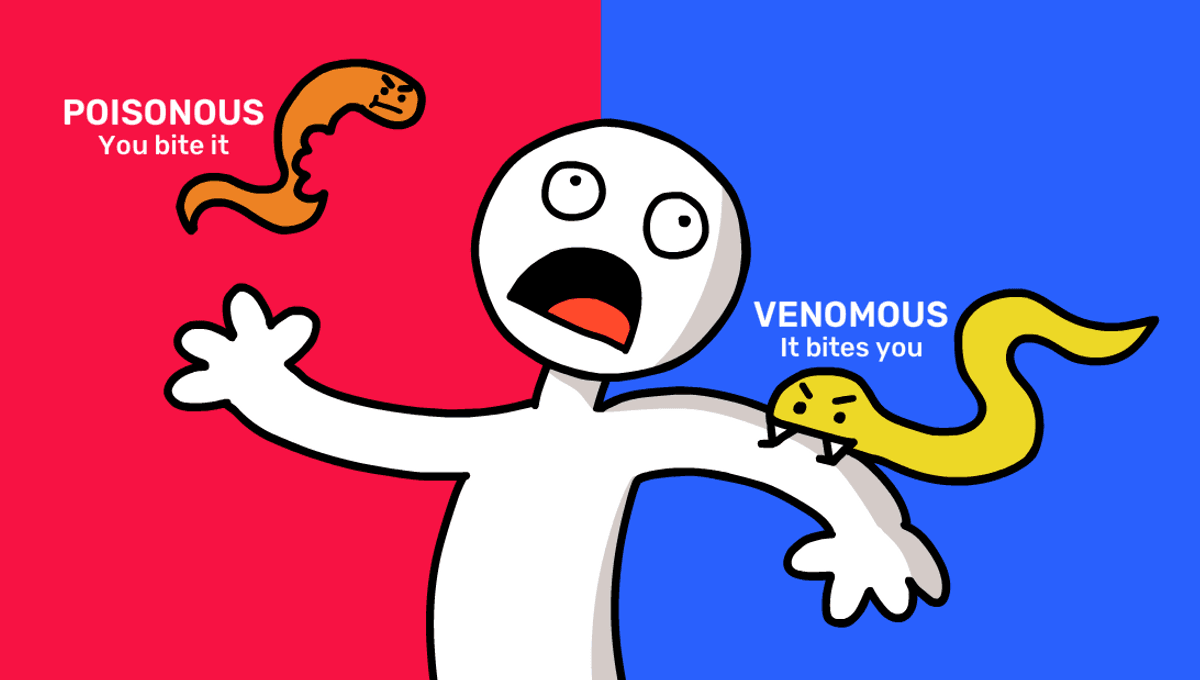
Welcome to the wonderful world of animal toxicity and the confusing question of: poisonous or venomous? Here we break down what each term means and some of the animals each term belongs to.
People love to use the phrase, “If it bites you and you die it’s venomous, and if you bite it and you die, it’s poisonous”. And that about sums it up, but let’s dive into the nitty gritty of each term.
What is venom?
Venomous creatures inject their toxin into you. It could be from the stinger of an insect, or the fangs of a venomous snake like a black mamba (Dendroaspis polylepis) or a king cobra (Ophiophagus hannah). The most venomous species in the world is widely considered to be the box jellyfish, which has tentacles loaded with tiny darts known as nematocysts that can be fatal to humans. Other sea creatures like the blue-ringed octopus (genus Hapalochlaena) are also venomous, and are often picked up by tourists curious about their unusual appearance.
The best-known venomous mammal might be the funky looking platypus (Ornithorhynchus anatinus). Males have a spur on the inside of their lower leg that can cause intense pain to humans when it penetrates the skin. But that’s the key point: the venom has to enter your bloodstream through a wound, usually a bite or sting mark left by the animal.
What is poison?
Lots of things can be classed as poisons but you have to physically ingest the toxin present in the poison for it to affect you. It can be swallowed, inhaled, or even absorbed through the skin.
In terms of snakes, the garter snake has a harmless bite if it were to strike you. However if you fancied a snakey snack you might be in more trouble, as the species is actually poisonous due to its diet of newts and salamanders, which produce toxins that the snake stores away in its body.
Everyone’s favorite tiny frogs, the poison dart frogs (genus Dendrobatidae) even store their toxins on their skin. They are poisonous rather than venomous because even a little lick from a human might be fatal to anyone unlucky enough to try one.
On a molecular level there are differences too. “Poison has very small chemical molecules that can easily pass through your skin. The molecules of venom are too big to be absorbed, so they have to be injected,” said Dr Ronald Jenner, venom evolution expert at the Natural History Museum in London, in a statement on their website.
A bit of both
Of course there are animals that like to be that little bit extra and are both poisonous and venomous. Some species of snake are venomous in the normal way but become poisonous as well because of their diet, such as the red-necked keelback snake (Rhabdophis subminiatus).
Don’t forget the plants and fungi
Plants and mushrooms can also be either venomous or poisonous. The stinging nettle is technically venomous since it uses a stinger to inject its toxins, but can be consumed safely. On the other hand lots of fungal species are poisonous and can be fatal when ingested, which is why it’s so important to check with a mushroom expert before chowing down.
Source Link: Poison Vs Venom: Do You Know The Difference?